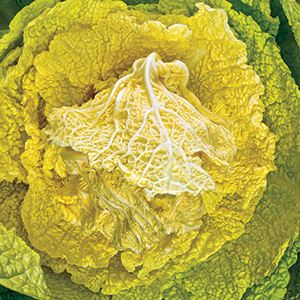In the Tech Museum, former Microsoft Chief Technology Officer Nathan Myhrvold stands in front of a nine-foot-tall exploding diagram of a mushroom Swiss burger. A gorgeous color photograph, it reminds me of those quirky grade school biology textbooks, but from a more Zen perspective. I see things I don’t normally see. The lettuce slice is probably three feet in diameter.
Myhrvold points to the burger, glossing over the history of exploding diagrams for a few seconds before elaborating on his approach to food photography. In the burger’s case, more has been revealed.
“It shows you how to assemble it, all the layers that you can’t see normally,” says Myhrvold. “It has this nerdy pedagogical purpose. When you usually go into a place and order a hamburger, you can’t see all the layers.”
More than 75 other large-format photographs of food comprise the rest of the exhibit, “The Photography of Modernist Cuisine: The Exhibition,” all of which were taken by Nathan Myhrvold and his Modernist Cuisine team. One doesn’t have to pay the museum admission to see the show.
In one corner, ultra-microscopic shots provide entirely new visual depictions of potato starch, Vitamin C and whipped cream. Another shot in the group provides an eerie close-up of a Trichinella worm in pork meat. It looks like something from an H.P. Lovecraft story. In the text panel, Myhrvold writes: “Seen through a microscope, the tiny roundworm that has frightened chefs into horribly overcooking pork for decades doesn’t seem so scary—in fact, it has an otherworldly beauty. Some people seeing this photo think it’s a distant nebula.”
Across the wall, one sees a head of cabbage blown up into a 71″ x 47″ image, just a little smaller than a full-size bed. Titled Fifty Shades of Green, the image almost looks computer-generated, varying from ochre green to a pale yellowish-white. Its outer layers appear darker from more exposure to sunlight, while its inner layers verge on colorlessness.
In another case, 1,000 digital shots were stitched together to make a panorama of steak, nine feet long. I scope out extreme closeups of raspberries, a wine decanter, an octopus with ink, a chicken foot, plus a gorgeously creepy image of sea urchin with chocolate pasta. In the latter case, the sea urchins resemble giant tongues in a mass of cartilage, again, resembling some otherworldly Lovecraftian nightmarescape.
Just the food shots alone would have sufficed for a phenomenal exhibit, but Myhrvold includes several ingenious cross-sections of appliances. That is, a pressure cooker, a barbecue and a Viking oven were each chopped in half in order for viewers to see the inner workings of the appliance. In the case of the oven, two professional machinists spent four solid days cutting a Viking oven and range in half, piece by individual piece. They started at the top, with the burners, and worked their way downward, disassembling and cutting as they went. The cuts are all made in the same vertical plane, enabling viewers to see half of a Viking oven, a cross section, right in front of their eyes, at the Tech Museum. For the pressure cooker, one sees mason jars of food inside the cooker. For the barbecue, I see two hamburgers cooking on top, as well as the reactions of the flames performing the cooking. It looks like Photoshop, but it isn’t.
“We wanted to show people a vision of food they haven’t seen before,” Myhrvold tells me afterward. “If you go into a fast food outlet from a big chain, you’ll see all these impossibly good-looking photos. If you go buy food magazines, almost every November, tons of magazines will have this Thanksgiving turkey, this tableau, and it’s like it came out of a Norman Rockwell painting. And it’s a way of looking at food. But we wanted to cause people to look at food in a different way. We wanted to zoom in very close and show people that there’s a whole world to the food that they’re totally missing. Or zooming out in a big way. Or cutting things in half. And trying to find this unique perspective that shows you something you just wouldn’t see normally.”



